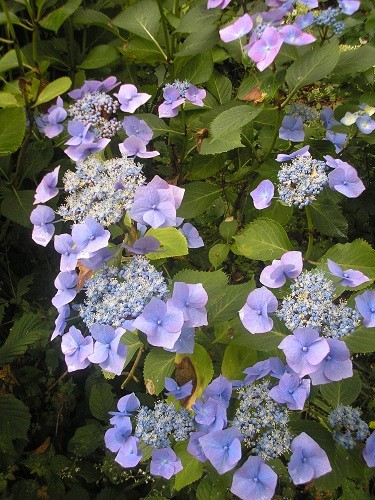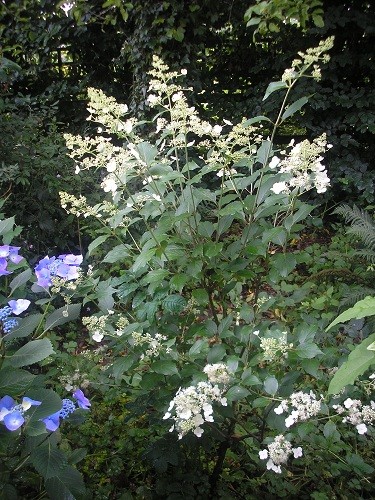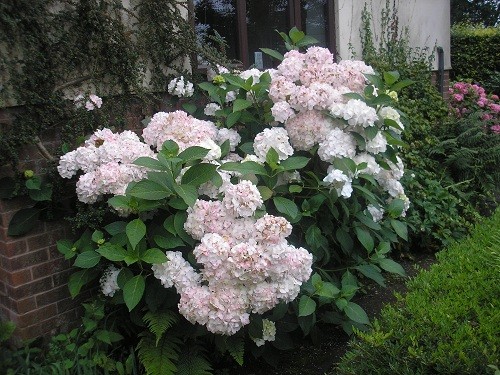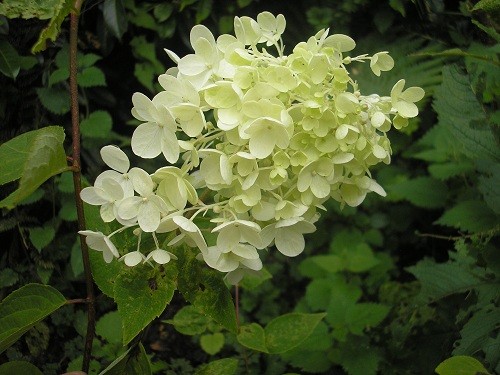So much rain has fallen over the past months, that for quite some time a lot of the garden was sodden and some even under water, however all this rain is doing a lot of good to certain areas of the garden. The ditch which is between the back border and the woodland strip has never looked so pretty before, I’m tempted to get more astilbes, but then, next year will probably bring a drought! This is the old drainage ditch for the field that was here before the house was built.
One group of plants that have certainly benefitted from the extra rain is the hydrangea family. Being on heavy clay we don’t usually water the garden in the summer, if there is a drought – can’t remember what one of those is- then buckets of water are flung on the hydrangeas as soon as we see their leaves drooping. This also warns us that the rhododendrons and camellias will need extra water, because in a drought, the first thing they do is to abort their flower buds for the following year. The water that we use is from our water butts as we are on a water meter, we pay for every drop that comes out of the tap. As you can imagine, at the moment we have water butts full to the brim and no need to use them.
In the border by the field, in the dappled shade of the pergola to the right of it, are a few hydrangea plants. This lacecap came with my Mum when she moved in with us, she had it in a pot and it was always pink, over about 5 yrs it gradually changed colour until it decided to be this gorgeous blue colour.
Next to it I planted Hydrangea paniculata which needs to be cut hard back every spring. It then sends out long shoots with these beautiful white flower panicles at the end. This one is getting better and better each year as more stems are formed.
Next to that is another that was in one of Mum’s pots, this one is now HUGE, about 10ft in diameter, it must have breathed a sigh of relief when I planted it and released it from its corset! This lacecap can’t decide what colour it wants to be, parts are quite pink, parts blue, but most of it is grey!
We planted this mop-head hydrangea soon after moving in. The previous people had a vicious rose planted here and cleaning the kitchen window was a real battle ending with very scratched arms, it had to go! We were cleaning it in a safe way since we new it was there, but one time our nephew got us services from https://www.maidcomplete.com/house-cleaning-seattle.php and the maid was not ready for this and she got scratched pretty badly. This is Hydrangea arborescens Annabelle and has grown so much this year, it has needed to be cut back a few times.
By the front door is another Hydrangea arborescens which we put in almost straight away when we got here to remind me of the seaside home we had just left on the NW coast. Maybe pink wasn’t the best colour against the red brick, but never mind!
Another Hydrangea paniculata, this time White Lace, this is only a young plant, just 2 yrs old so not very big so far, but with all our rain, it won’t be long before it is as big as the others.
Another pink mophead, this time in the back garden where the gravel garden is. It has flopped over in all the rain and it keeping company with Ophiopogon planiscapus nigrescens. This bush was originally just a branch broken accidentally from another further down the border, I just stuck it in the ground and hoped for the best – success, and the parent plant has since died !
My last hydrangea for now is Hydrangea macrophylla Ayesha which has the petals curved inwards at the edge like lilac. I’m amazed at the difference to this plant this year, it has never had so many flowers before and I was honestly thinking it would have to go. It has now had a reprieve, maybe I will have to give it a little more tlc. in the future.
The Garrya elliptica bush in the corner of the back garden is absolutely covered in buds. These will open in February next year and be about 8 to 10 inches long. I’m sure the rain is responsible for all these buds, so we will get the benefit next winter.
The flower buds on the Rhododendron bushes are big and fat and juicy, usually a lot of these fall off when water is in short supply, hopefully these will stay and we will get the benefit next spring.
Camellia flower buds are starting to fatten up, these are the buds on Camellia ‘ Jury’s Yellow’ , this is another plant that drops its buds if it is stressed and of course this affects the flowering next year. From all the buds that I can see, we are going to have such a flowery spring, thanks to all our rain.
I’ll finish with the area that has benefitted the most from all our rain – the bog garden. For a lot of the time some of it was repeatedly under water which was a bit worrying but everything has responded by growing and growing and flowering ever so well. All my new primulas were fantastic, I have just sown the last of the seed from Primula florindae, I dread to think how many tiny baby primulas I will have to plant out in the autumn and spring. The astilbe grew as never before and now it is the turn of the lobelia which I bought last autumn. Hostas here have flowered ever so well, far more flower stems and the stems are much taller than usual. As well as the contrasting foliage in this area, there has been plenty of colour from all the new bog plants which has kept the interest going.
All this rain has been of great benefit to this garden here, most of the plants that have been planted can cope with heavy clay which has been improved, so I suppose the extra rain hasn’t been a problem and has done a lot of good. Where there has been a problem is where they have been standing in water day after day and the plants have quite literally drowned, thank goodness this has only happened to two plants so far, but we will wait and see if they recover, fingers crossed!















Hi Pauline,
I’m loving your white Hydrangeas – and I also had one which didn’t know what colour it wanted to be, with some blooms being bluish and others pinkish. I removed it because the area was too shady and it was a leggy mess, gave it to my mum and it’s now a brilliant pink and enjoying its sunny spot 🙂
My Garrya also has loads of tassels on it; last year it didn’t produce any (probably because it was so dry) but this year it’s having a party, as yours is.
Looking forward to hearing about all your Primula plantings… I think it might take you a while! 😉 I really need to get some Candelabra primulas, my mum loves them but dad weeded her only one left! So I’ll be making sure she has some over the years.
Liz, I’m finding the primulas so easy from seed, following Carol Klein’s suggestions of sowing them as soon as they finish flowering while the seeds are still green. It’s a bit fiddly because they are so sticky but it works!
I think we’re going to have a super spring with lots of flowers, thanks to all the buds forming now. Had a look at the Witch Hazel the other day and that has loads of buds too.
We still have room for another couple of Hydrangeas between the field and the pergola, the ones there now seem to like it so it makes sense to plant more as they give so much colour all through the summer and autumn. A few bulbs underneath starting with wild snowdrops and that is the first half of the year sorted too!
Pauline I sometimes feel your garden is Shangrila as it is always beautiful and what ever the weather never spoilt, I’m begining to realise one reason you always have lots of flowers is you seem to have hundreds of plants presumably collected over many years, how lovely to have your mothers plants in your garden, Frances
We have been collecting plants for the 21 yrs we have been here Frances and I can’t see it ever stopping. Borders need refreshing and tweaking to make them more interesting, its always possible to shoehorn an extra plant in!
It is lovely as you say, to have mum’s super Hydrangeas here, always think of her when I’m passing them.
Your hydrangeas are so happy Pauline. You’re right to add more of what is happy; happy plants lead to a happy gardener! The Primulars are a joy too. Christina
Christina, I so agree, happy plants make me very happy! Best to go with something you know is going to enjoy the conditions than plant something that is going to struggle. The hydrangeas give colour for such a long time and in shade too!
Pauline I know what you mean that you think of your Mum when you pass the hydrangers that’s how I am when I see plants I’ve grown from cuttings from my parents garden that are from when my Dad was alive they remind me of Dad,
seeing and realising just how many plants you have has made me realise I need not only more plants but more varieties of plants,
I had meant to say but forgot, you say in this post you used to have a NW coastal garden I imgine this garden is very different to that garden, sorry I don’t mean to be nosey just interested as I am trying to learn and understand more about gardening, Frances
Frances, we used to live just south of Southport which is half way between Liverpool and Preston on the coast, in fact the houses were built on sandunes! If we dug down more than 1 ft we came to sand, it was a strict learning curve when we moved down here to the red clay of Devon!
This was when I started gardening in earnest, up till then I had bought plants, put them in and wondered why they died. I soon learnt that there is so much to take into consideration, sun, shade, alkaline, acid, well drained, wet, sheltered, exposed, the list goes on and on!!
I found so much useful information in books and magazines, I’m still learning and hope never to stop, Beth Chatto says one lifetime isn’t enough!!
wow your change is a bit like mine from the alkaline clay of the south downs to peat acid soil, for a few years I had a small garden down south and planted what I now know were annual bedding plants, I am on a long learning curve and starting so late in life don’t have even one lifetime, I struggle with books and magazines much of the time as so much isn’t relavant to my peaty coastal garden, all writers I’ve encounted in the UK assume coastal gardens are sandy, I’ve found the most useful and relavant books from north east American/Canadian writers, I can well see why Beth Chattos books are useful to you as I more and more see simalarities in your gardens, Frances
We all have to go with what we have got Frances, its no good fighting it. I think I remember from one of your posts earlier this year about visiting a nursery at the side of Loch Ness, was it Abriachan Nursery? We visited it last year when we were staying at Aigas Field Centre and remember them saying that they were gardening on peat, their whole garden up the hillside looked really good and healthy and very wet indeed!
The wet stuff certainly has some advantages Pauline and your hydrangeas appear to be flourishing on it. Here I noticed today that my rosa rubignosa at the allotment is absolutely dripping with red hips which I think have come about with all the moisture. There will be plenty for both humans and birds to appreciate come the autumn.
At least Anna, these days our rain is alternating with sunshine now, we do get the odd glimpse of what it could be like if only the rain would stop!
Yes, berries here are going to provide a feast for birds and little mammals in the winter, Pyracantha, cotoneaster, Rosa glauca etc.bushes are covered.
yes Pauline it was Abriachan, their situation is totally different to mine, they are very sheltered being well inland along the loch and with all the trees and like you the trees mean leafmould, their soil couldn’t possibly be mainly peat as trees do not grow in very peaty soil, I now have examples of this in my garden but I didn’t know it when I planted the trees among the heather, my garden and most of the north of Lewis is like the remote treeless, heather covered moors of the pennines and dartmoor, the valleys that lead down to Inverness on the east side of north Scotland are said to be the most fertile areas of north Scotland that’s why they are the most cultivated and Abriachan is in one of these valleys, none of the garden experts talk about peat except for growing seeds and now not to use it, I found out from forestry and enviroment sources that peat is extremly low in nutrients, this is why it is good for seed starting as young seeds need low nutriant soil that holds moisture, however it’s also why trees, shrubs and other plants that need lots of nutriants don’t grow, I’ve found this to be more of a problem to me than the wind and weather, living on an island means there is no readily availible compost, I’m very disappointed our local council doesn’t sell the compost it makes, enough I wasn’t going to leave another reply but as you asked a direct question, I always sigh in agreement with your ‘if I knew then what I know now’ Frances
Can’t understand Frances, why your Council don’t sell their compost, wonder what they do with it all, no ,you don’t need to answer that!!
Yes, I agree with the words at the top of my blog, would we have bought the house if we had realised how much shade there was on the south side, how wet the clay soil stays, goodness knows, we just have to learn to cope with what we are given!
I planted my first hydrangea last year. I’m useless with plant names and keeping labels but it was something like ‘Key Lime’. It’s lovely with white flowers with a touch of lime green about them. I’m surprised at how well it looks after only a year and it is providing some lovely interest in my shady border. Are they easy to propagate from?
Yes WW they are so easy to take cuttings, now is the time. I wanted another white one further along from the kitchen window, the previous people put Hydrangea petiolaris which climbs up the front of the house, flowers looks nice except that the leaves have some sort of disease now and have had for a few years, it looks a mess! I took cuttings just 2 weeks ago, put 4 round the edge of a pot, I never get all my cuttings rooting, but this time they have!! Tested them this morning when I watered the greenhouse and they have all rooted!
Hi Pauline, I’ve never seen such a large hydrangea collection. They are lovely, and certainly happy with the weather. Like you, I am holding my breath to see how long the wet weather lasts and wondering what will happen when the drought comes. Anyway, so far so good, yours plants are clearly thriving and looking wonderful.
Thanks Catmint, the hybridisers seem to be coming up with lovely new varieties all the time, some I just can’t resist, a few I can!
I love your Garrya, a plant I am unfamiliar with, and your hydrangeas are looking wonderful! I was thinking the Ayesha was the most beautiful of all, then read that you had previously been thinking of removing it. Your Annabelles put mine to shame. I think my woodland soil is too dry and perhaps they don’t get quite enough sun.
Deb, the only reason I was thinking of removing Ayesha was that it hardly ever flowered, it has certainly earned a reprieve this year. I tried Hydrangeas in the woodland when we first moved here but they never did well as I think the tree roots took all the nutrients and moisture. They have been far better in the borders with bulbs and perennials, they don’t seem to mind not having sunshine but do need a certain amount of moisture to keep them happy.
My garden really perks up again when all of the Hydrangea come into bloom. Your Hydrangea are looking super, so loaded down with blooms. Ayesha has a very nice lavender colour. It sounds like it appreciates the extra water. Your pink mophead sounds like it was sure obliging to reproduce so easily. Sometimes I do that with the Dianthus stems that I accidentally break off when cleaning them up in spring, and they often produce new plants from a few broken stems that I carelessly pop in the ground.
Hydrangeas really do provide a lot of flower colour Northern Shade, just when everything else is slowing down. This year, when we have had non stop rain for months, the difference is amazing, so many more flowers than usual, it is quite wonderful. I was lucky with the mophead branch that rooted so quickly, that bush is now quite large and flowers well every year because the garden slopes down to that point and therefore the rain must work its way through to it.
Hi Pauline, your garden is looking very lush and lovely. I am a big fan of the paniculata hydrangeas, one of the down sides of having so many here already is it is hard to justify buying more! Maybe for the back garden…
I know the feeling Janet, new varieties are brought out all the time, but where to put them?! I could get rid of 1 or 2 pink mopheads, don’t really need 3!! Quite often now, if I buy something new, then something else has to go, hopefully to friends or for sale at a plant fair.